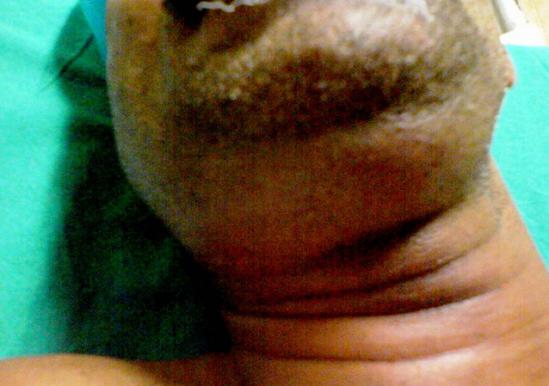Ludwig’s angina is a rare, serious skin infection that develops on the floor of the mouth and the neck. It results from bacteria that are present due to other issues, such as a tooth abscess or a mouth injury.
With antibiotics, people usually recover from Ludwig’s angina. However, if a person does not receive treatment promptly or if the infection is severe, it can lead to potentially fatal complications, such as sepsis.
Keep reading for more information about this rare infection.
 Share on Pinterest
Share on PinterestLudwig’s angina is a bacterial skin disease that causes swelling and pain under the tongue. It gets its name from the German physician Wilhelm Friedrich von Ludwig, who first identified the condition in 1836.
Ludwig’s angina is a rare form of cellulitis. It causes swelling in the tissues under the tongue and in the neck. The swelling can be so severe that it cuts off the person’s airways and prevents them from swallowing saliva. If a person does not receive treatment, Ludwig’s angina can be fatal.
Anyone who has trouble breathing should receive emergency medical aid. A person who experiences any other symptoms of Ludwig’s angina should receive prompt attention from a doctor.
The most common cause of this disease is a recent dental infection, often in the lower molars.
 Share on Pinterest
Share on PinterestImage credit: Anand H Kulkarni, Swarupa D Pai, Basant Bhattarai, Sumesh T Rao and M Ambareesha, 2008
Ludwig’s angina causes swelling in the mouth and neck. The swelling can become so severe that it restricts the person’s breathing.
The most common symptoms of Ludwig’s angina are:
Less common symptoms include:
- mouth pain
- tongue swelling
- voice hoarseness
- drooling
- a sore throat
Some people with Ludwig’s angina experience:
- an earache
- confusion or other changes in thinking
- fatigue, excessive tiredness, or weakness
If a person experiences trouble breathing, they should seek emergency medical attention, such as by calling 911.
If a person experiences any other symptoms of Ludwig’s angina, they should contact a doctor for an appointment as soon as possible, as early treatment helps prevent complications.
Ludwig’s angina is a bacterial infection. It often results from common bacteria, such as Streptococcus or Staphylococcus. This type of cellulitis usually develops due to a tooth infection.
Other conditions can increase the risk of developing Ludwig’s angina, including:
- cuts or other injuries in the mouth
- poor dental hygiene
- tooth extraction
Typically, diagnosing Ludwig’s angina starts with a physical examination. The doctor will examine the neck and head for redness and swelling. They may also use imaging and test fluids to confirm the diagnosis.
A doctor can often diagnose Ludwig’s angina when one or more of the following symptoms are present:
- redness or swelling of the tongue, neck, or head
- extreme swelling of the tongue
- the tongue being out of place
- swelling on the floor of the mouth
If a visual examination is not sufficient, the doctor will likely order an MRI or CT scan of the head and neck. This can help them better visualize the swelling.
The doctor may also order a fluid culture to check for the presence of bacteria.
Severe, life threatening complications can result from Ludwig’s angina, including:
- blocked airways
- sepsis
- septic shock, which occurs when sepsis causes dangerously low blood pressure and cellular changes
Receiving prompt treatment for Ludwig’s angina can usually prevent these and other complications.
If the swelling in the tongue or neck becomes so severe that it blocks the airways, the person needs immediate medical attention. Emergency responders will open up the airways to provide oxygen.
In some cases, the team needs to perform an emergency surgery called a tracheostomy. This involves opening a hole in the neck to allow air to flow into the windpipe.
Antibiotics are the primary treatment for Ludwig’s angina. At first, the person will likely receive these drugs intravenously — through an IV. This will usually continue until the symptoms go away. The person may then need to take oral antibiotics for some time.
To help the swelling go down, a healthcare provider may also need to drain fluid and pus from a person’s mouth. Some people also need dental surgery to repair any damage.
Preventing Ludwig’s angina usually involves keeping the mouth clean and visiting the dentist regularly.
Ludwig’s angina is a rare skin infection that affects the floor of the mouth and the neck.
It can be life threatening, but with prompt treatment, it is usually possible to prevent serious complications.
A doctor can typically diagnose Ludwig’s angina with an examination. Typical treatment involves antibiotics, tooth or mouth repair, and draining excess fluids.
Anyone who experiences trouble breathing — a symptom of this infection — should receive immediate medical attention.
Let’s block ads! (Why?)






